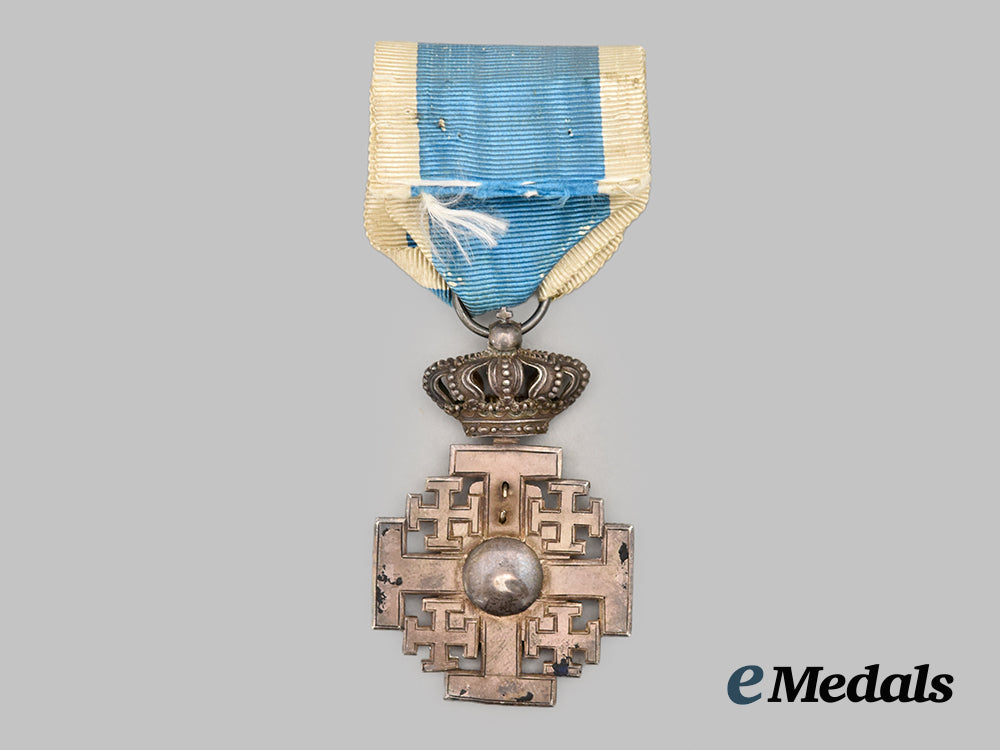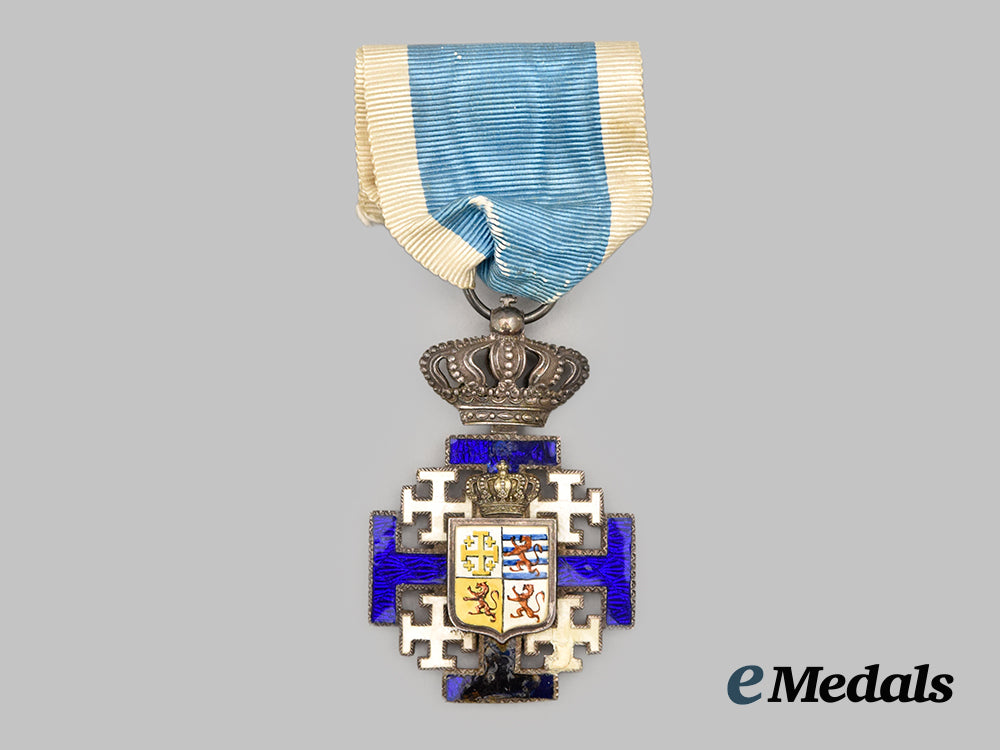
LOADING ...
In response to evolving domestic opinion, eMedals Inc has made the conscious decision to remove the presentation of German Third Reich historical artifacts from our online catalogue. For three decades, eMedals Inc has made an effort to preserve history in all its forms. As historians and researchers, we have managed sensitive articles and materials with the greatest of care and respect for their past and present social context. We acknowledge the growing sentiments put forth by the Canadian public and have taken proactive actions to address this opinion.


International. An Order Of Melusine, Officer
International. An Order Of Melusine, Officer
SKU: ITEM: EU22219
Current Bid:
Your Max Bid:
Bid History:
Time Remaining:
Couldn't load pickup availability
Shipping Details
Shipping Details
eMedals offers rapid domestic and international shipping. Orders received prior to 12:00pm (EST) will be shipped on the same business day.* Orders placed on Canadian Federal holidays will be dispatched the subsequent business day. Courier tracking numbers are provided for all shipments. All items purchased from eMedals can be returned for a full monetary refund or merchandise credit, providing the criteria presented in our Terms & Conditions are met. *Please note that the addition of a COA may impact dispatch time.
Shipping Details
eMedals offers rapid domestic and international shipping. Orders received prior to 12:00pm (EST) will be shipped on the same business day.* Orders placed on Canadian Federal holidays will be dispatched the subsequent business day. Courier tracking numbers are provided for all shipments. All items purchased from eMedals can be returned for a full monetary refund or merchandise credit, providing the criteria presented in our Terms & Conditions are met. *Please note that the addition of a COA may impact dispatch time.
Description
Description
Instituted in 1881. In silver gilt with navy blue, white and red enamels, the base formed by a Jerusalem cross, obverse illustrating the coat-of-arms of the Lusignan kings of Cyprus in the center that is surmounted by a crown, enamels not intact at the bottom (damaged), original ribbon, extremely fine.
Footnote:
1. The Order of Melusine was created in 1881 by 'Marie de Lusignan', wife of 'Guy de Lusignan', self-styled Prince of Jerusalem, of Cyprus and of Armenia. When he died in 1905, her lover took over as 'Grand Master', having awarded himself the title 'Comte d'Alby de Gratigny'. The Order seems to have become defunct about 1910. The founder of the order and her husband were, however, well known for creating orders for financial gain and social prestige and he seems to have started life named 'Kafta' and to have become a Maronite priest before taking on a royal title.
2. The House of Lusignan was a royal house of French origin, which at various times ruled several principalities in Europe and the Levant, including the kingdoms of Jerusalem, Cyprus, and Armenia, from the twelfth through the fifteenth centuries during the Middle Ages. It also had great influence in England and France. The family originated in Lusignan, in Poitou, western France, in the early tenth century. By the end of the eleventh century, the family had risen to become the most prominent petty lords in the region from their castle at Lusignan. In the late twelfth century, through marriages and inheritance, a cadet branch of the family came to control the kingdoms of Jerusalem and Cyprus. In the early thirteenth century, the main branch succeeded to the Counties of La Marche and Angoulême. As Crusader kings in the Latin East, they soon had connections with the Hethumid rulers of the Kingdom of Cilicia, which they inherited through marriage in the mid-fourteenth century. The Armenian branch fled to France, and eventually Russia after the Mamluk conquest of their kingdom. The claim was taken by the Cypriot branch, until their line failed. This kingdom was annexed by the Republic of Venice in the late fifteenth century.
Description
Instituted in 1881. In silver gilt with navy blue, white and red enamels, the base formed by a Jerusalem cross, obverse illustrating the coat-of-arms of the Lusignan kings of Cyprus in the center that is surmounted by a crown, enamels not intact at the bottom (damaged), original ribbon, extremely fine.
Footnote:
1. The Order of Melusine was created in 1881 by 'Marie de Lusignan', wife of 'Guy de Lusignan', self-styled Prince of Jerusalem, of Cyprus and of Armenia. When he died in 1905, her lover took over as 'Grand Master', having awarded himself the title 'Comte d'Alby de Gratigny'. The Order seems to have become defunct about 1910. The founder of the order and her husband were, however, well known for creating orders for financial gain and social prestige and he seems to have started life named 'Kafta' and to have become a Maronite priest before taking on a royal title.
2. The House of Lusignan was a royal house of French origin, which at various times ruled several principalities in Europe and the Levant, including the kingdoms of Jerusalem, Cyprus, and Armenia, from the twelfth through the fifteenth centuries during the Middle Ages. It also had great influence in England and France. The family originated in Lusignan, in Poitou, western France, in the early tenth century. By the end of the eleventh century, the family had risen to become the most prominent petty lords in the region from their castle at Lusignan. In the late twelfth century, through marriages and inheritance, a cadet branch of the family came to control the kingdoms of Jerusalem and Cyprus. In the early thirteenth century, the main branch succeeded to the Counties of La Marche and Angoulême. As Crusader kings in the Latin East, they soon had connections with the Hethumid rulers of the Kingdom of Cilicia, which they inherited through marriage in the mid-fourteenth century. The Armenian branch fled to France, and eventually Russia after the Mamluk conquest of their kingdom. The claim was taken by the Cypriot branch, until their line failed. This kingdom was annexed by the Republic of Venice in the late fifteenth century.


You May Also Like
Germany, SA. A Model 1933 Service Dagger, SA-Gruppe Nordsee, by Friedrich von der Kohlen
G59818
Germany, SA. A Model 1933 Service Dagger, SA-Gruppe Pommern, by Gustav Wirth
G59816
Germany, Third Reich. A Mixed Lot of Tyrolean Marksmanship Badges
G52930
Germany, SS. An Estonian Waffen-SS Volunteer’s Sleeve Shield
G50381
Germany, SS. A Waffen-SS Sturmmann Sleeve Insignia
G52846
-
Germany, SA. A Model 1933 Service Dagger, SA-Gruppe Nordsee, by Friedrich von der Kohlen
G59818
Add to CartRegular price $980 USDRegular price $0 USD Sale price $980 USDUnit price / per -
Germany, SA. A Model 1933 Service Dagger, SA-Gruppe Pommern, by Gustav Wirth
G59816
Add to CartRegular price $980 USDRegular price $0 USD Sale price $980 USDUnit price / per -
Germany, Third Reich. A Mixed Lot of Tyrolean Marksmanship Badges
G52930
Add to CartRegular price $135 USDRegular price $0 USD Sale price $135 USDUnit price / per -
Germany, SS. An Estonian Waffen-SS Volunteer’s Sleeve Shield
G50381
Add to CartRegular price $150 USDRegular price $0 USD Sale price $150 USDUnit price / per -
Germany, SS. A Waffen-SS Sturmmann Sleeve Insignia
G52846
Add to CartRegular price $135 USDRegular price $0 USD Sale price $135 USDUnit price / per
Do you have a similar item you are interested in selling?
Please complete the form and our client care representatives will contact you.
Sell Item








